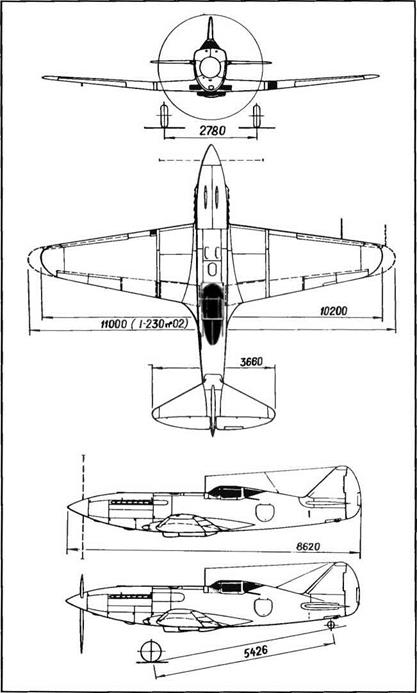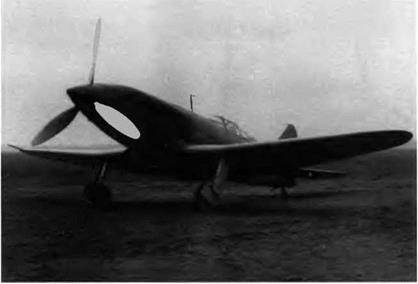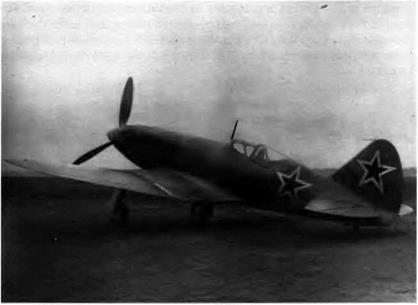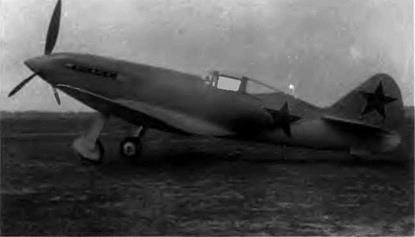MiG-311 /1230 / D
The aims of this program were not very different from those of the previous designs—that is, improving the aerodynamics, handling qualities, and production processes of the MiG-3 even though its assembly lines were now closed. The motivation of this new attempt was to give the MiG-3 a successor without departing too much from the original design.
Compared to the MiG-3, the 1-230’s fuselage was 370 mm (14 57 inches) longer. The main landing gear was modified and equipped with more efficient and reliable shock absorbers, and the pilot’s view was greatly improved. Aware of the scarcity of light alloys in 1942, the designers called for the fuselage to be made entirely of wood except at the engine mounting
|
The 1-230 would have entered mass production, but the engine was not available. Prototype no 01 had no antenna mast. |
At the time of the preliminary design, the utmost was done so that the 1-230 might be manufactured on the same assembly lines as the MiG-3, with the same production tooling and methods. The quality of the skin finishing and the aerodynamic cleanness of the airframe were superb The aircraft was really a beauty.
The ventral radiator bath underneath the wing center section was moved forward and made much smaller. A slightly bigger wing was used on an experimental basis to increase the aircraft’s ceiling by 500 m (1,640 feet). But this was not considered enough of an improvement to justify acceptance of the new wing.
The team in charge of this program ran into an old snag. The AM- 35A, the only suitable engine for this type of aircraft, was no longer being produced. The AM-38F was certainly not the ideal engine for a fighter—and besides, its entire production run was reserved for the 11-2. Consequently, the 1-230 was fitted with a salvaged AM-35A. The flight reports filed by MiG-3 pilots were taken into account: firepower was increased by mounting two synchronized 20-mm ShVAK (SP-20) cannons on top of the engine (150 rpg) The 1-230 became the first singleengine MiG equipped with cannons.
The aircraft was first flown and flight-tested in August 1942. Even though the results were positive, there was uncertainty in 1943 over whether series production could he launched. After the prototype rollout, five preproduction aircraft were completed in the ОКБ workshop and delivered to the 1 GvIAP (1st Guards fighter aviation regiment) for

|
|
[-230 prototype no. 02 had a larger wingspan. |
combat proving on the Kalinin front, where they performed with distinction. Nonetheless, the chaotic circumstances of most engine manufacturers in this period (evacuation of production factories, establishment of new production facilities in distant places, and difficulties in managerial staff recruitment) made it impossible to resume production of the AM-35A. Despite all its good qualities, the 1-230 did not succeed the MiG-3.
The 1-230 is sometimes called the MiG-3 D (Dalnostniy, long range) or MiG-3U (Ulushchenniy, improved).
Specifications
Span, 10.2 m (33 ft 5.6 in); 1-230 no. 02 span, 11m (36 ft 1 in); length, 8.62 m (28 ft 3.4 in); wheel track, 2.78 m (9 ft 1.4 in); wheel base, 5.426 m (17 ft 9.6 in); wing area, 17.44 m2 (187.7 sq ft); 1-230 no. 02 wing area, 18 m2 (193.75 sq ft); empty weight, 2,612 kg (5,757 lb); takeoff weight, 3,285 kg (7,240 lb); fuel, 324 kg (714 lb); oil, 56 kg (123 lb); wing loading, 188.4/182.5 kg/m2 (38.57/37.36 lb/sq ft); max operating limit load factor, 8.
Performance
Max speed, 660 km/h at 6,000 m (356 kt at 19,680 ft); max speed at sea level, 560 km/h (302 kt); climb to 5,000 m (16,400 ft) in 6.2 min; service ceiling, 11,500 m (37,700 ft); 1-230 no. 02 service ceiling, 12,000 m (39,360 ft); range, 1,350 km (840 mi).

|













